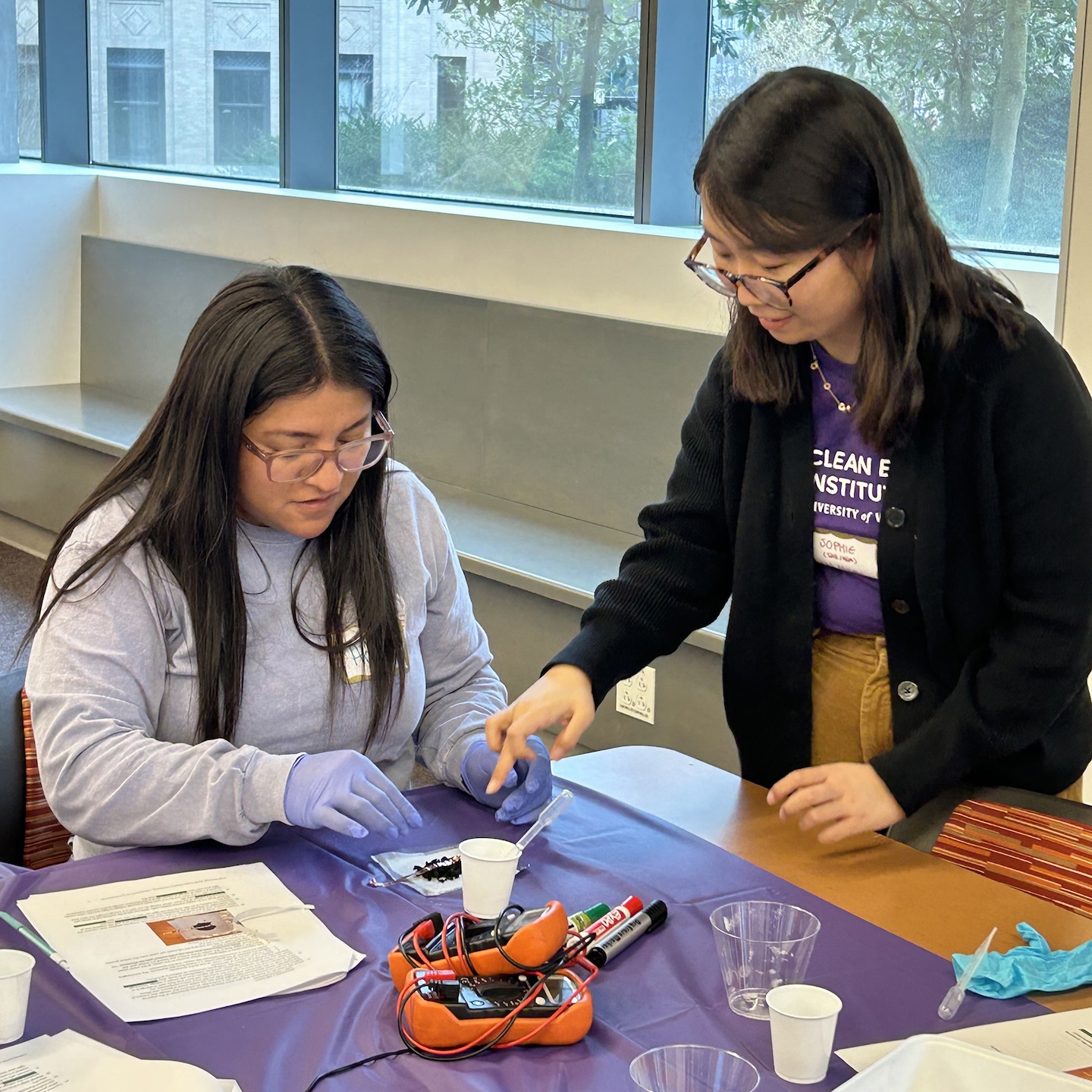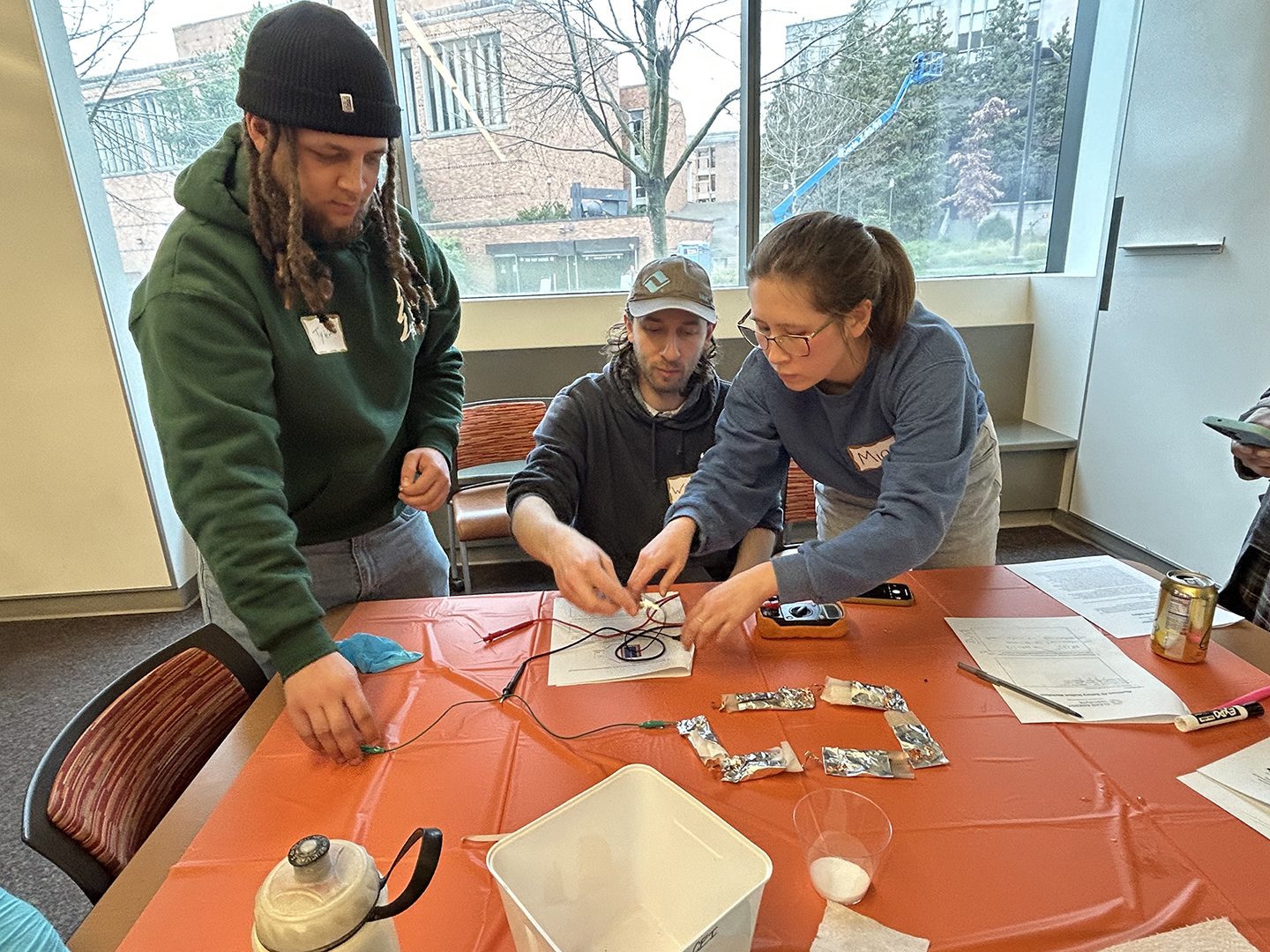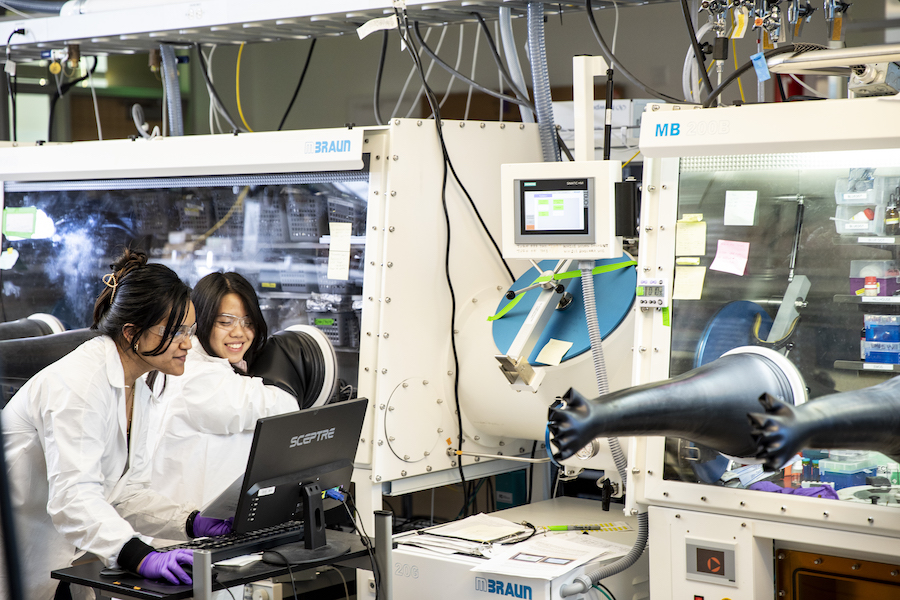
April 21, 2025
On March 8, 2025, the Center for Integration of Modern Materials on Demand (IMOD), a National Science Foundation (NSF) Science & Technology Center (STC), partnered with the University of Washington (UW) Clean Energy Institute (CEI) to host an all-day workshop for STEM educators at Seattle-area secondary schools. The goal was for teachers to explore ways to integrate cutting-edge research in clean energy, quantum science and engineering, and optoelectronics into their curricula.
Nineteen local educators participated in two hands-on STEM activities, connected with CEI and IMOD researchers, and toured CEI’s Research Training Testbed at the UW’s Seattle campus. The workshop was organized and led by Danica Hendrickson, CEI’s Associate Director of Education & Workforce Engagement, and Caroline Long, IMOD’s Director of Education & Workforce Engagement. Six UW trainees helped lead hands-on activities.
When asked, “What were some of the strengths of the workshop?”, participants shared:
- “Time to engage hands-on to see what our students would experience in lessons was super useful. That, paired with copies of teacher and student facing materials, really brought to life ideas we could use to bring authentic research into the classroom.”
- “How fun it was to work together with others and to be really engaged in the activities together — the collaborative effort!”
- “Absolutely fantastic. Balanced between fun and applicable hands-on activities, and ‘lecture’ = pure learning. Good balance of teacher hat and learner hat.”
Hands-on STEM activities
Clean energy researchers are trying to find new chemistries for high energy density batteries from earth-abundant materials that are safe, reliable, and recyclable. This activity involves using everyday materials, including aluminum foil, salt water, charcoal, and copper foil, to build a non-rechargeable battery cell capable of powering an LED.

For next-generation solar panels, researchers are seeking new materials that are cheaper to manufacture than conventional silicon. One of these techniques is dye sensitization: using a coating of colorful molecules to absorb more sunlight at certain wavelengths. These materials can be rapidly coated onto flexible substrates at a much lower cost than the high-energy clean rooms required to fabricate a silicon solar panel.
This activity uses raspberry juice as the sensitizing substance: when pigments known as anthocyanins (responsible for red, blue, and purple colors in many fruits and vegetables) absorb sunlight, they give off electrons that can be captured by a transparent semiconductor coated onto glass.

When asked, “What was one of the biggest insights or takeaways from the workshop?”, participant feedback on the hands-on activities included:
- “I loved the aluminum-air battery — I will likely try a version of this with my students.”
- “I really enjoyed the class activities. Building the solar cell with raspberries, as well as creating the series of batteries with charcoal and aluminum foil, were really cool hands-on activities that seemed to go well together (create energy, then store energy) and were student friendly.”
Connecting cutting-edge research to STEM education
The following UW researchers presented at the workshop:

Dr. Fangyuan Jiang is a member of Prof. David Ginger’s lab at the UW, which is part of both CEI and IMOD. She is working to understand new semiconductors by investigating their fundamental properties, and how to integrate them into new functional devices. These electronic and optical properties are key to all kinds of modern technologies, including computer chips, lasers, light-emitting diodes (LEDs), and solar panels.
Reagan Beers, a CEI Graduate Fellow in molecular engineering at the UW, is developing two-dimensional (2D) materials made of non-toxic elements with a range of sustainability applications. Her research in the Aquatic Innovations in Materials Science Lab led by Prof. Jessica Ray is focused on water treatment, but 2D materials are also useful for energy storage and computing. With a molecularly flat surface, researchers can manipulate cloud-like electronic charges by changing the elements within a 2D material, and they can also attach different functional molecules to filter harmful substances from water.

When asked, “What was one of the biggest insights or takeaways from the workshop?”, participant feedback on the research talks included:
- “I loved hearing from the researchers about their work and their experiences in scientific higher ed — super valuable to put our work in perspective.”
- “How we can start teaching some of the real science in graduate work to secondary students with simple experiments.”
- “Understanding the interconnectivity between so many different disciplines (chemistry, optoelectronics, solar energy) and realizing how they all work together towards the goal of clean energy and other solutions.”
The UW’s lab for interdisciplinary training
Beers also led a tour of the Research Training Testbed, which provides UW students access to industrial-quality research tools across clean energy disciplines.

CEI member faculty created a hands-on course housed in the RTT, “Energy Materials, Devices, and Systems (EMDS),” to train students across the scales of clean energy. Upper-division undergraduates and graduate students get project-based training on materials for energy generation and storage, and the integration of renewables into energy systems.
The RTT and EMDS course embody the interdisciplinary understanding that is required to address grand challenges like the clean energy transition. By incorporating big-picture ideas into K–12 STEM classes, teachers can empower students with knowledge that supports higher education and impactful careers in science and engineering.
For more information about CEI’s programs for K-12 education, visit these pages or contact Danica Hendrickson at danicah@uw.edu.




